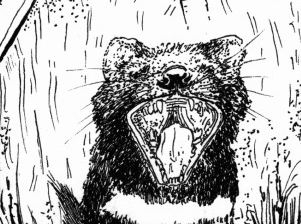 Humans are not the only species suffering under the decimating force that is cancer. Over the past two decades, Tasmanian Devil populations have been swiftly wiped out from large cancerous tumours. Growing on their faces in golf-ball-sized masses, the tumours prevent the uptake of food, resulting in eventual death by starvation and breakdown of body function. In comparison to the human fight against cancer, where significant progress is slow at best, the battle to cure the Tasmanian Devil facial tumour disease is beginning to make real headway. Recent publications in national newspapers are hinting at a breakthrough – a possible means to cure the cancer killing these native marsupials. Such a finding is huge news for the internationally collaborating scientists, who have already developed immunization against the disease for healthy Devils awaiting release into insurance populations in the wild.
Humans are not the only species suffering under the decimating force that is cancer. Over the past two decades, Tasmanian Devil populations have been swiftly wiped out from large cancerous tumours. Growing on their faces in golf-ball-sized masses, the tumours prevent the uptake of food, resulting in eventual death by starvation and breakdown of body function. In comparison to the human fight against cancer, where significant progress is slow at best, the battle to cure the Tasmanian Devil facial tumour disease is beginning to make real headway. Recent publications in national newspapers are hinting at a breakthrough – a possible means to cure the cancer killing these native marsupials. Such a finding is huge news for the internationally collaborating scientists, who have already developed immunization against the disease for healthy Devils awaiting release into insurance populations in the wild.
The Tasmanian Devil is notorious for its vicious nature. Individuals are often engaged in scrappy fights involving significant amounts of biting, scratching, and resultant scarring. In fact, according to the Devils@Cradle sanctuary, one of the ways to determine the breeding success and aptitude of a male Devil is by the level of scarring on his hind – the more scratches and scarred tissue, the more active he has been during breeding seasons. Unfortunately, this tendency to fight one another, inherent in Devils across Tasmania, is one of the primary transmission tactics the cancer utilizes to spread amongst populations. Two animals engaged in a fight will use their canines to bite at one another – if a non-diseased animal comes into direct contact with a diseased animal’s tumour (i.e. it’s canine makes contact with the facial tumour on the diseased Devil) it becomes highly likely that cancerous cells will be transmitted to, and infect, the healthy animal. Save the Tasmanian Devil Program likens this transmission to an organ transplant, only instead of the animal receiving a life-saving organ; its transplant is a life-threatening cancer.
The recent breakthrough led by the University of Tasmania (UTAS) suggests that the Devil’s cancer can be cured by cancer. Scientists have discovered that when injecting live cancer cells into infected Devils, the Devil’s immune system has the ability to recognize the disease and develop the appropriate immunity mechanisms to fight it off. Results have been staggeringly positive, with large tumours shrinking and disappearing over three months following the injection. This method of disease handling is termed, ‘immunotherapy’ – the prevention or treatment of disease with substances that stimulate the immune response. It is hoped that this finding will facilitate the development of a vaccine even more effective and quicker working, so as to reverse, or at least halt, the decline of Tasmanian Devils in the wild from this disease – a figure that currently stands at 80% population drop in the last 20 years.
Whilst this finding is Tasmanian Devil-specific, overall research into the nature and development of the facial tumour disease in Tasmanian Devils has the potential to enable understanding of how cancers behave in other species. It is possible that some of the findings and research conducted on these carnivorous marsupials may help in the fight against human cancers, by informing on how cancer evolves and how infected individuals can beat the disease.
Words by Maddi Howard, art by Danyon Burge.
This article first appeared in print volume 88 edition 3 SOAP.

